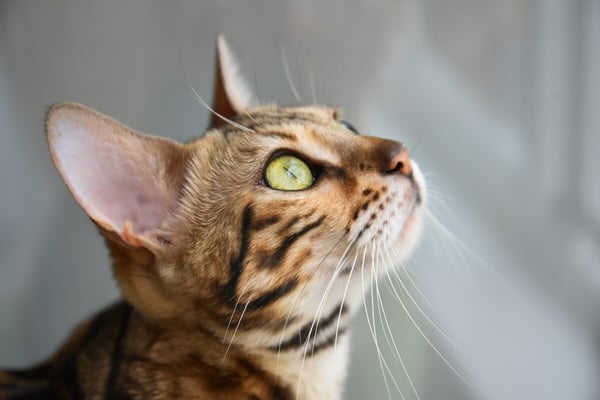Curious Kitties! Why Do Cats Have Whiskers?
Where would your cat be without its whiskers? From a visual point of view, it wouldn’t look as cute, of course, but whiskers do have an important job to do! They are your cat’s ultimate sensory tool, and although they look like hairs, they are thicker and longer than normal hair, and are in fact highly sensitive radars.
WHY DO CATS HAVE WHISKERS?
When we draw a cat, we always draw their whiskers coming out either side of their nose, but did you know they have whiskers (vibrissae) over the rest of their body too - and they all have a job to do:
- Whiskers either side of a cat’s nose, are called the mystacial whiskers. Cats use these whiskers to measure the environment they are in - like a built-in tape measure. They have 12 of these whiskers either side of their nose, completely symmetrical, which will help them work out if they will fit through an opening.
- Around their eyebrows, they have the superciliary whiskers. These whiskers help protect your cat’s eyes and detect any movement around the eyes, causing them to blink and protect the eye from injury.
- Along their chin, there’s the genal whiskers. These do a similar job to the superciliary whiskers, particularly useful when your cat is prowling through long grass or bushes; they trigger a blink that will protect your cat’s eyes from being damaged.
- And on the back of their forelegs just above their paws, their whiskers are called the carpal whiskers. Domestic cats will be well fed at home, but sometimes they instinctively like to hunt and the carpal whiskers help with this. Cats have great long sighted vision but can’t see things very well up close, which means if their prey is very near, they cannot always see it clearly. The carpal whiskers help them detect their prey so that they can sense, pounce and catch and keep it close with their claws.

HOW DO CAT’S WHISKERS WORK?
Whiskers are part of a cat’s sensory system which sends information to their brain. They sense vibrations in the air currents around them and detect moving prey or even sense approaching danger.
Anything closer than 30 cm is not clear to a cat, so whiskers act as a navigation tool in their environment – their whiskers are so sensitive they can detect where something is, its size and also its texture.
You can also tell how your cat is feeling from their body language and by their whiskers. If their whiskers are flat against their face, it could mean your cat is feeling anxious or threatened. A relaxed and happy cat will have their whiskers fanned out to the side of their face, but a curious cat will move their whiskers forward to explore or hunt.

HOW DO I LOOK AFTER MY CAT’S WHISKERS
Whiskers are vital to a cat’s feline sensors, so they should never be cut or trimmed. If a cat’s whiskers are removed, they will lose all sense of their surroundings and feel disoriented.
There’s no need to clean a cat or their whiskers. A cat will clean its whiskers in their normal grooming process, usually beginning with cleaning around their face and whiskers first, followed by the rest of their body from top to tail.
Old whiskers do fall out but are replaced by new ones, and as your cat grows older, they may turn darker in colour - this is normal. However, if you notice that your cat is losing whiskers more frequently or they break off, get them checked by a vet in case there are any underlying medical issues.
Don’t worry if your cat has curly whiskers! Some breeds, such as the Selkirk Rex, have curly hair and curly whiskers - this is absolutely beautiful and normal.
